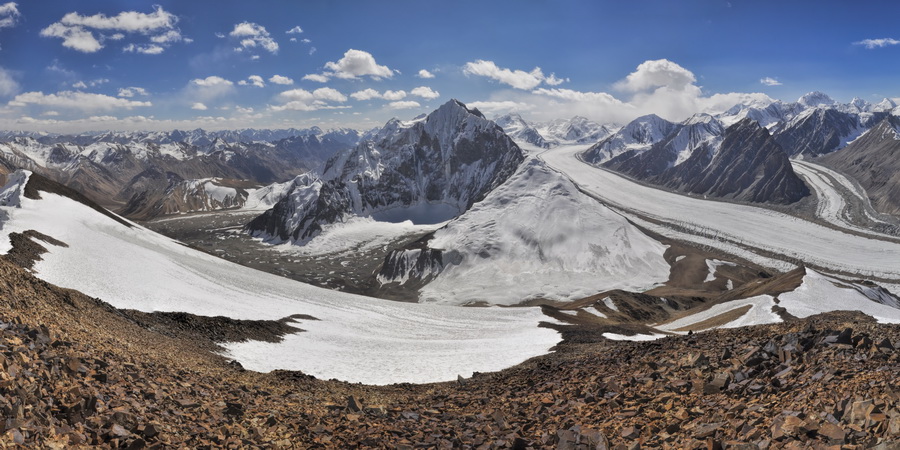Pamir Mountains, Tajikistan

Mountains of Tajikistan. Passes and Mountains of Tajikistan regions
The Pamir Mountains are a mountain range located in Central Asia which are formed by the junction or knot of the Tian Shan, Karakoram, Kunlun, and Hindu Kush ranges. They are among the world's highest mountains; in Victorian times they were known as the 'Roof of the World'. They are also known by the Chinese name of Congling or 'Onion Mountains.'
The Pamir range is centered in the Tajikistan region of Gorno-Badakhshan. Parts of the Pamir also lie in the countries of Kyrgyzstan, Afghanistan, Pakistan, Indian Kashmir and China. Not only are they they some of the highest mountains, but they represent some of the most severe climate and biological extremes on the planet. In addition to being extremely cold most of the year, most areas in the Pamir are high deserts; receiving from 5 cm to 30 cm a year (2-12 in). This, in combination with the altitude and climate, prevents the growth of trees and shrubs in most areas, leaving only sparse grasses to cover the tortured geological forms of the peaks and valleys.
Wildlife is likewise scarce; though majestic endangered species such as Marco Polo sheep (Ovis ammon polii) and snow leopard (Uncia uncia) exist in small numbers. Other mammalian species known to occur in the region are ibex (Capra ibex sibirica), brown bear (Ursus arctos), wolf (Canis lupus), red fox (Vulpes vulpes), lynx (Lynx lynx), Pallas' cat (Otocolobus manul), stone marten (Martes foina), Altai weasel (Mustela altaica), stoat (Mustela erminea), long-tailed marmot (Marmota caudata), hare (Lepus tolai), pikas (Ochotona sp.), and a host of smaller mammals.
Its highest summits are: Ismoil Somoni Peak (known from 1932-1962 as Stalin Peak, and from 1962-1998 as Communism Peak), 7,495m (24,590 ft); Ibn Sina Peak (still unofficially known as Lenin Peak), 7,134 m (23,406 ft); Peak Korzhenevskaya (in Russian, Pik Korzhenevskoi), 7,105m (23,310 ft); Independence Peak (Revolution) 6,974m (22,881 ft); Karl Marx 6,726m (22,067 ft); Engels 6,507 m (21,348 ft) and Mayakovskii 6,096 m (20,000 ft).
There are countless glaciers in the Pamir Mountains, including the 48-mile-long (77 km) Fedchenko Glacier, the longest in the former USSR and the longest glacier outside the Polar region. The glaciers of the Pamir are one of the largest water sources for all of Central Asia; this resource, mostly flowing through the Pyanj and Vakhsh rivers, combines to form the Amu-Darya, which provides most of the irrigation water for the massive agricultural enterprises of Uzbekistan and Turkmenistan.
Covered in snow throughout the year, the Pamirs have long and bitterly cold winters, and short, cool summers. Annual precipitation ranges from 5130 mm), which supports grasslands but few trees.
Coal is mined in the west, though sheep herding in upper meadowlands are the primary source of income for the region.
